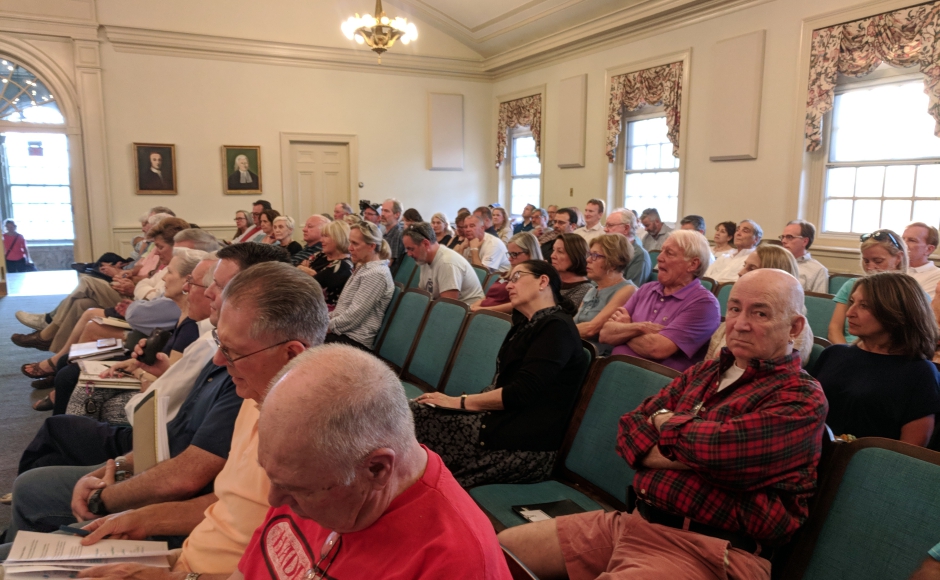But an attorney for Fair Share housing says age-targeting is illegal, and the borough must address its affordable housing obligation first.
By Matt Skoufalos | May 15, 2018
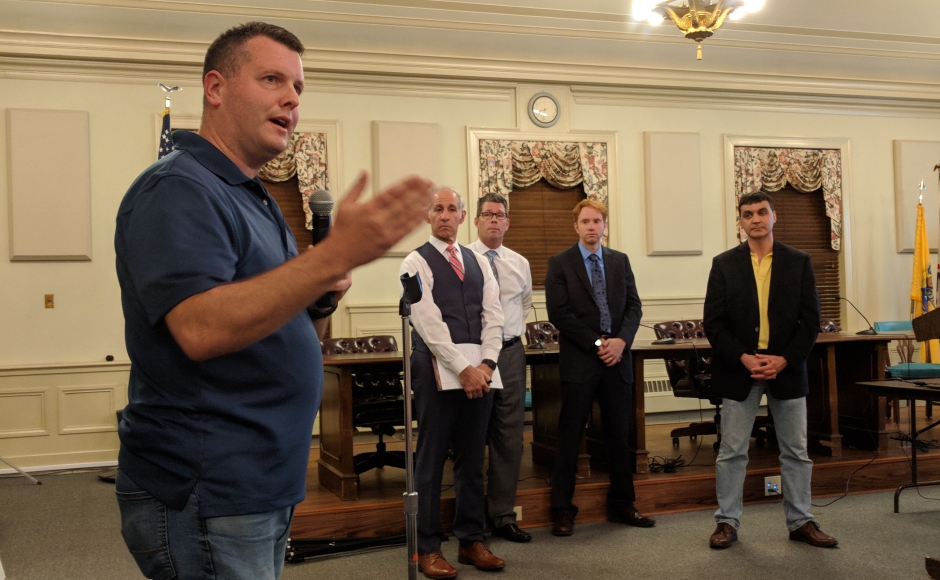
Chris Maynes, a plaintiff in a suit against Haddonfield over the Bancroft redevelopment, speaks at an information session May 2. Credit: Matt Skoufalos.
The May 2 meeting was supposed to be an information session for Haddonfield residents to unpack the details of a redevelopment plan for the 19-acre Bancroft parcel.
Instead, it descended into shrieking at three project developers and a borough commissioner who’d only last year won re-election on an unopposed ticket.
Such is the nature of discussing the Bancroft property in Haddonfield.
The largest undeveloped piece of land in a fully developed town is a prize long coveted by the local government, borough school district, and private developers, all of which have made various runs at acquiring it in the past decade.
The one who emerged with it, J. Brian O’Neill, raised a rancor with his plans to create a behavioral treatment center there. After formally approving a redevelopment plan for the site, Haddonfield commissioners spent 18 months negotiating to buy the property back at public insistence.
Yet since cutting a deal to build a 55-plus townhouse-and-duplex community there, the current administration now faces a lawsuit from eight residents (including two former mayors) who claim the plan will create “school-busting townhomes.”
This refrain was echoed repeatedly at the information session, and has been a principal and public concern of the plaintiffs since prior to the suit’s filing. Haddonfield simply can’t take on any more families with kids, they say, because its seniors, many of whom self-identified as 30- and 40-year borough residents, deserve the right to age in place, affordably.
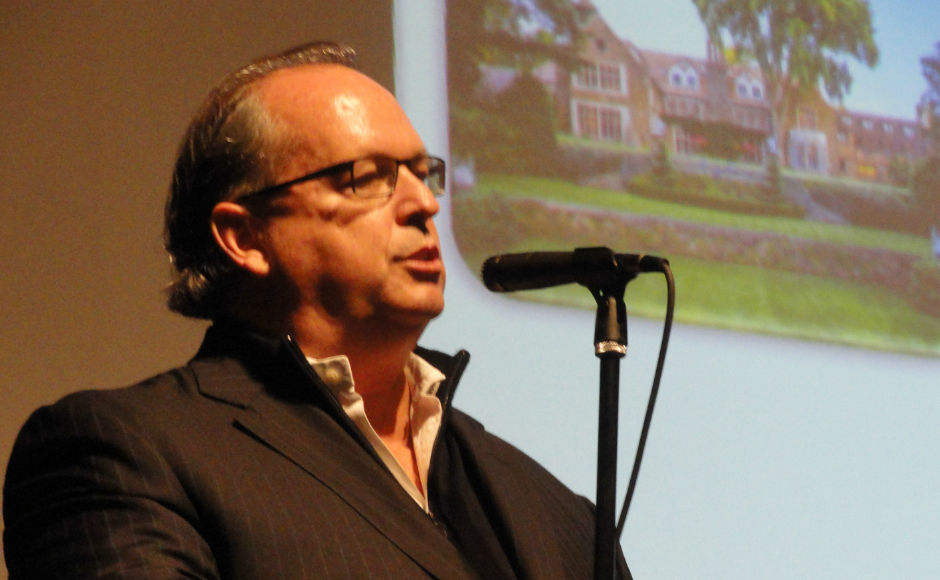
File photo: developer J. Brian O’Neill speaks about plans for the Bancroft parcel in a public meeting. Credit: Matt Skoufalos.
This argument establishes the Haddonfield school district, conflictingly, as at once the pride of the borough and the bane of its taxpayers.
Fifty-eight cents out of every dollar collected locally goes to the district of a town so white (94 percent) and wealthy ($135,000 median household income) that there is no financial relief to speak of in the form of state aid.
The school system is a great driver of the $487,700 median local property value, which effectively prices out homebuyers who might lend the district some ethnic and economic diversity.
The legal remedy of affordable housing is meant to create opportunities for families earning less than that to access such vibrant communities. It’s also meant to keep seniors from being forced out from them.
But in 2018, the average American who has owned a home anywhere in the country since the early 1980s (read: seniors) will have benefited from a quadrupling of its value. In that time, the barrier to home ownership has been raised significantly.
O’Neill’s plan proposes building 80 market-rate townhomes and 10 affordable units at Bancroft, three-quarters of which will have “age-targeted” floor plans: ground-floor master bedrooms; few, wide, and low-sloped stairs; no basements, and attics without livable space.
These will contain “age-in-place adaptability” features—grab bars, tall toilets, lowered kitchen sinks, roll-in showers, and remote-controlled appliances—said project architect Josh Eckert, with the master bedroom on the same floor as the principal communal living space, or with elevators that connect master to the living level, or with two master bedrooms.
None of this satisfied opponents of the plan, who argued publicly that the allure of the borough school district would be too strong for wealthy homebuyers to resist the opportunity to flock to town.
“Is it possible that families with kids come in and say, ‘Well, even if you offer it as an option with these accessibility features, what if they don’t take them?” asked Chris Maynes, one of the parties in the lawsuit. “What if non-seniors move in, and these things become constructed permanently with two and three bedrooms upstairs… what is there to stop that from happening?”
“It’s crystal clear to me that what this town needs is decent downsizing ability for our seniors,” said Vic Murray. “This is not it. We need flats. We need 200 or so. It’s so clear to me, it’s not even close. I’m just saddened.”
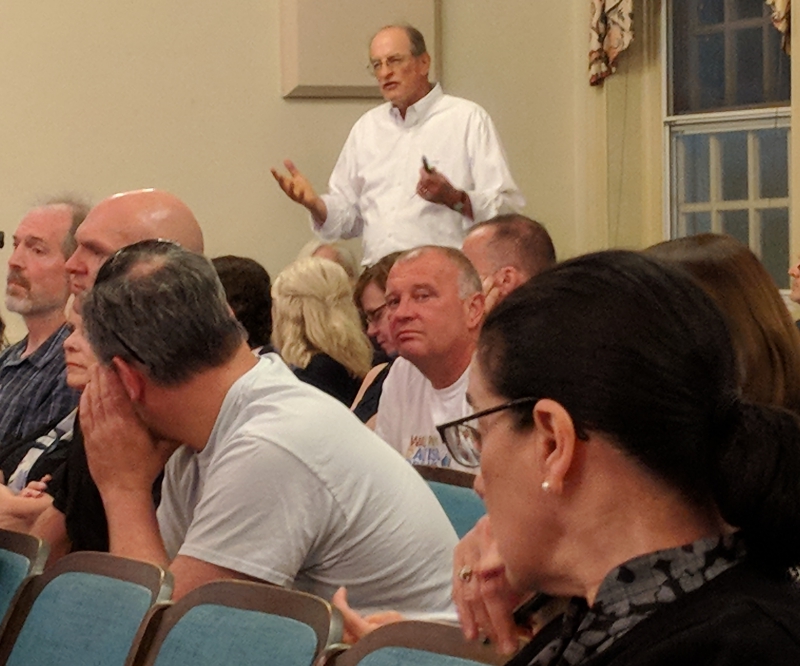
Haddonfield resident Vic Murray speaks at a public information meeting about the Bancroft redevelopment proposal. Credit: Matt Skoufalos.
Longtime Haddonfield planning board member John Stokes, also a party to the lawsuit, has recused himself from the application (albeit after voting against changes to the redevelopment plan in December).
But at the May 2 meeting, Stokes also criticized adding schoolchildren to the district through the project.
“The concern that many of us have, in addition to providing realistic opportunities for senior housing, is that if your best guess proves to be wrong, and we get a flood of families with children, we’re in bad shape, not only financially but in terms of the school facilities,” Stokes said.
“Let’s come up with a model that we stand a much better chance of getting seniors to buy into, and that is not this model,” he said.
Interviewed after the meeting, Stokes sought to couch his position more in terms of advocating for downsizing seniors to remain in Haddonfield, which he said has been a horizon goal of the borough master plan for years, and less against families with school-aged children.
Failing to provide senior-specific housing is “abandoning a key objective of the town, which everyone has agreed to for a decade,” Stokes said. Worse, to his thinking, seniors who move out of town “are providing opportunities for families to move in,” he said.
“We have this trend of young families moving into town, and moving into large, reconstructed homes,” Stokes said. “We have this trend of empty-nesters moving out of town. [At the Bancroft parcel], we have an opportunity of providing opportunities for empty nesters, and avoiding the risk of flooding our school system.”
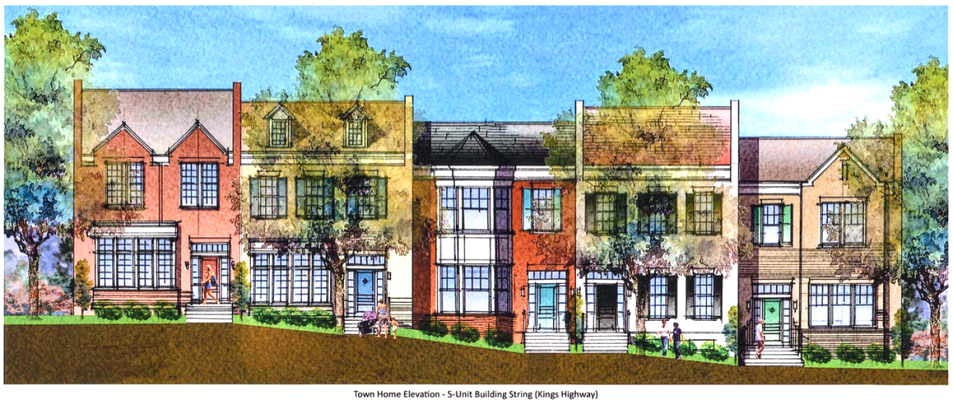
Conceptual renderings of townhomes facing Kings Highway at the Bancroft redevelopment site. Credit: City Invincible architects.
Acknowledging that “diversity in town is diminishing,” Stokes still believes it’s of greater urgency to create affordable senior-focused housing than to provide affordable units for families with children.
“Opportunities for families that don’t have the significant financial resources to locate in town are diminishing, and the opportunities for seniors to remain in town are greatly diminishing,” Stokes said.
“It’s a matter of valuing what the opportunities are and what the trends are and trying to deal with it.”
In fact, the majority of the affordable housing in Haddonfield exists in 48 apartments at the Birchwood Tarditi Commons, which are restricted to seniors 62 and older. (Four units at the Kings Court townhomes are dedicated as affordable housing, the result of a lawsuit from Fair Share Housing during the project’s rollout.)
The irony that prior Haddonfield mayors Jack Tardidi and Tish Colombi are plaintiffs to the suit is not lost on current Haddonfield Commissioner John Moscatelli, who argued that prior administrations had opportunities to address the borough’s affordable housing deficit, and “wouldn’t do it.”
“Why are we so far behind on COAH?” Moscatelli said. “Who were the administrations blocking COAH? Jack and Tish.”
Of course, Moscatelli also held office in 2014, when the borough government purchased the Boxwood property to avoid a builder’s remedy lawsuit. But buying the Bancroft parcel in order to prevent its redevelopment as an addictions treatment center required more complicated and expensive negotiations, he said.

Haddonfield Commissioners John Moscatelli, Jeff Kasko, and Neal Rochford in 2016. Credit: Matt Skoufalos.
“We had packed auditoriums of people demanding that we buy that land and stop [O’Neill],” Moscatelli said.
“We took care of that. That was absolutely the best deal that we could have gotten at the time.
“The negotiation was successful,” he said. “We came to an agreement. This is where we are.
“If Mr. O’Neill says he’s had enough of this and walks away, we can start again,” he said.
“I appreciate the angst, but there’s not much we can do about it.”
To get O’Neill to take any deal required guaranteeing him enough of a profit margin while keeping the borough from holding long-term debt so the agreement could be tax-neutral or tax-positive for the borough, Moscatelli said. Building the affordable senior housing scotches most of those terms, he said.
“Then the prices are lower, the tax revenues are lower, you’re not bringing in as much money to share with the school board, and you’re much more likely to be tax-negative,” Moscatelli said.
“We have a developer that isn’t going away, and at least has the ability to tie us up [in court] for an unacceptably long time,” he said. “Between the appellate and supreme court it could take five years. During that time, no other developer would be able to look at the property and do anything.
“There is no option that isn’t going to make some subgroup unhappy,” Moscatelli said.
Haddonfield Commissioner Jeff Kasko, who was mayor when the deal with O’Neill was brokered, said downsizing seniors already have other housing options in Haddonfield, including apartments, condominiums, and sub-$300,000 homes.
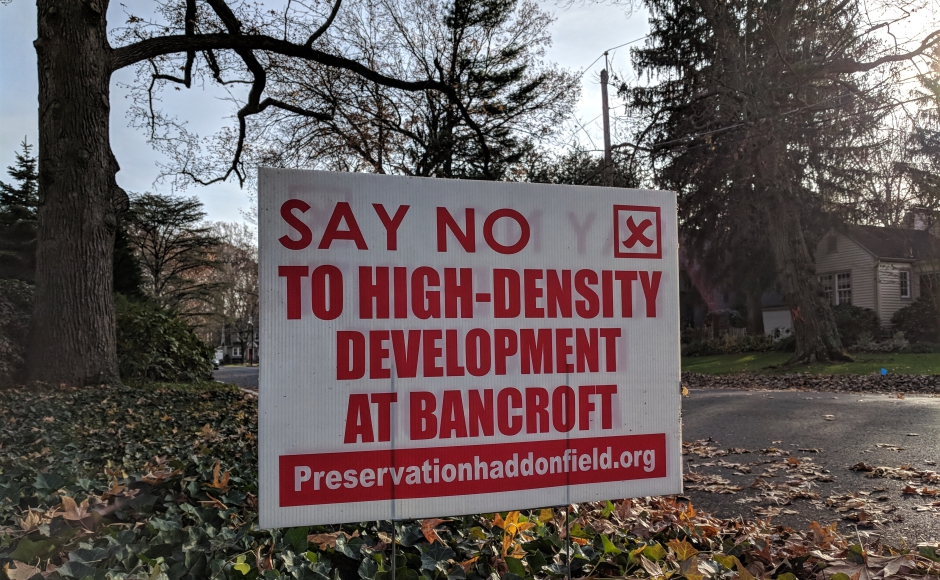
A remnant of 2012 politicking around the Bancroft redevelopment, spotted in Haddonfield in 2018 amid current discussions. Credit: Matt Skoufalos.
“There are more than 300 flats for rent or sale at multiple locations in town, including the Haddonfield Commons, Tarditi Commons, Haddonfield Manor, and Kingsway,” Kasko wrote in an open letter to the Haddonfield Sun.
“There are also hundreds of smaller, private homes and twin homes for downsizing. In total, there are more than 2,000 properties and housing units in town that are at or below the median property value of about $500,000,” Kasko wrote.
“There are more than 1,000 properties that are less than $250,000.”
“The redevelopment plan has always said the target price in these townhouses is going to be the [borough] median,” Kasko told NJ Pen. “It’s always been the median because that’s what works for the developer and that’s what works for the town. But ultimately, the market ends up deciding.”
The borough continues to struggle with teardowns and max-rebuilds of its older homes, which presents problems maintaining a diversity of housing, Kasko said. But he objects to the notion that adding school-aged children to the borough is a systemic problem.
“Why’s it bad that families want to come here and raise their kids in a town with a good school system?” he said. “Are we trying to shut them out?”
Attorney Kevin Walsh of Fair Share Housing said the plan for age-targeted housing does exactly that. The corporation already has a pre-existing suit against Haddonfield over the proposed Bancroft redevelopment. And from Walsh’s perspective, its claims are iron-clad compared with those of the former mayors, et al.
“Age-restricted [housing] is a non-starter,” given that the greater portion of Haddonfield’s only available affordable housing is already restricted to seniors, Walsh said.
“Age-targeted [housing] is illegal.”
“The whole notion of age targeting is illegal under federal law,” he said.
“You can’t say, ‘We don’t want families.’”
To Walsh, Haddonfield is South Jersey’s worst offender in terms of income-exclusive communities who have shirked their affordable housing obligations. He described the current debate as “a really disgusting microcosm of the tensions that play out all across New Jersey.”
“There is not a single affordable home in Haddonfield that the town provided,” Walsh said. “The four that are in Kings Court are there because we sued them.”
Furthermore, he said the former mayors named as plaintiffs in the lawsuit “did nothing for affordable housing” during their tenures at the helm of the borough.
“I’d love to take their depositions,” Walsh said.
To Walsh, appropriate use of the Bancroft site would be dense development at “30 units per acre, maybe more.
“Their [affordable housing] obligation is hundreds of homes, and they’re not going to get there,” he said.
“We’ve challenged the original redevelopment plan, and we’re in litigation over it,” Walsh said. “Haddonfield has not shown a willingness to be reasonable. It surprises me in part that Haddonfield has done this for so long.”
Please support NJ Pen with a subscription. Get e-mails, or follow us on Facebook, Twitter, and Instagram.

